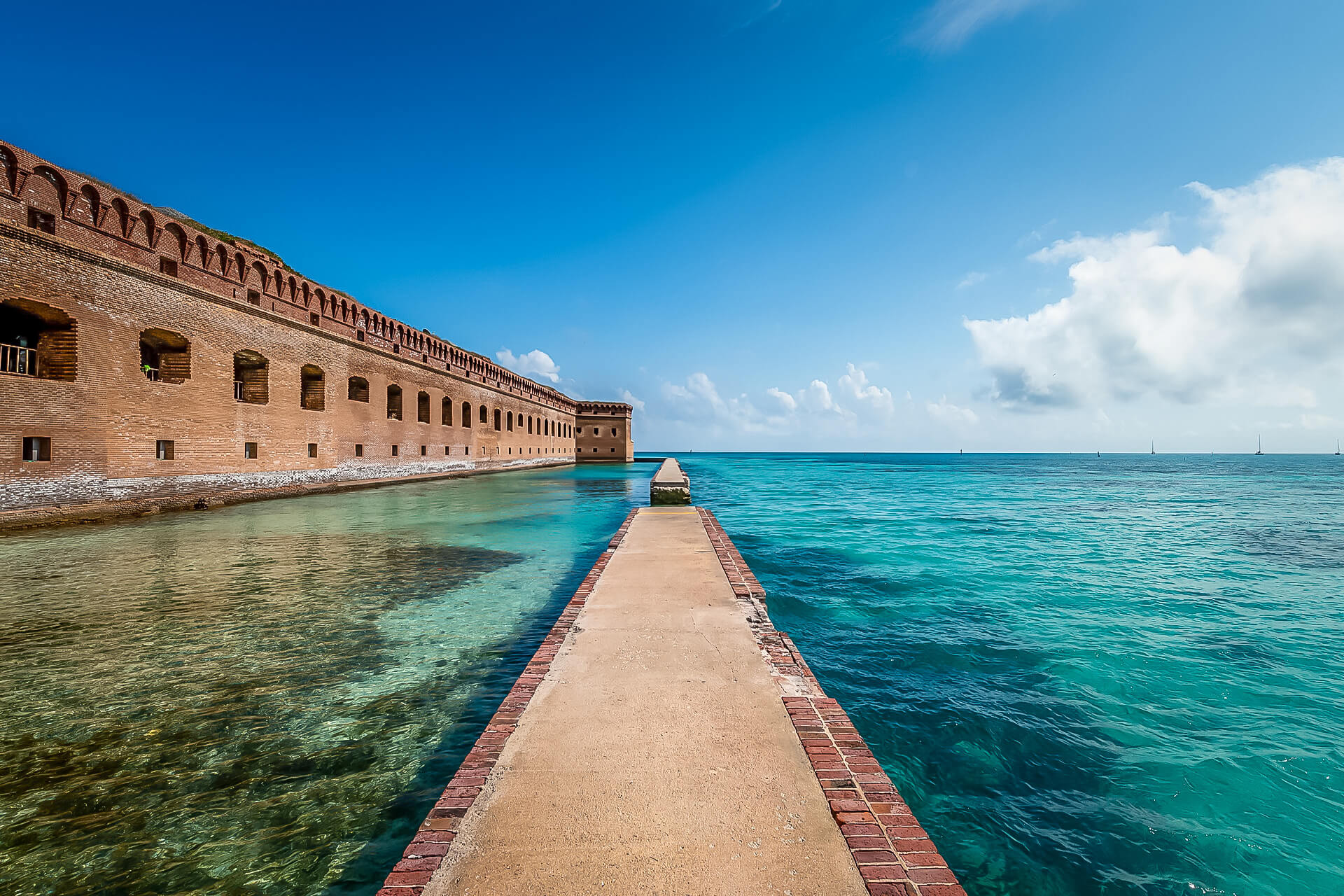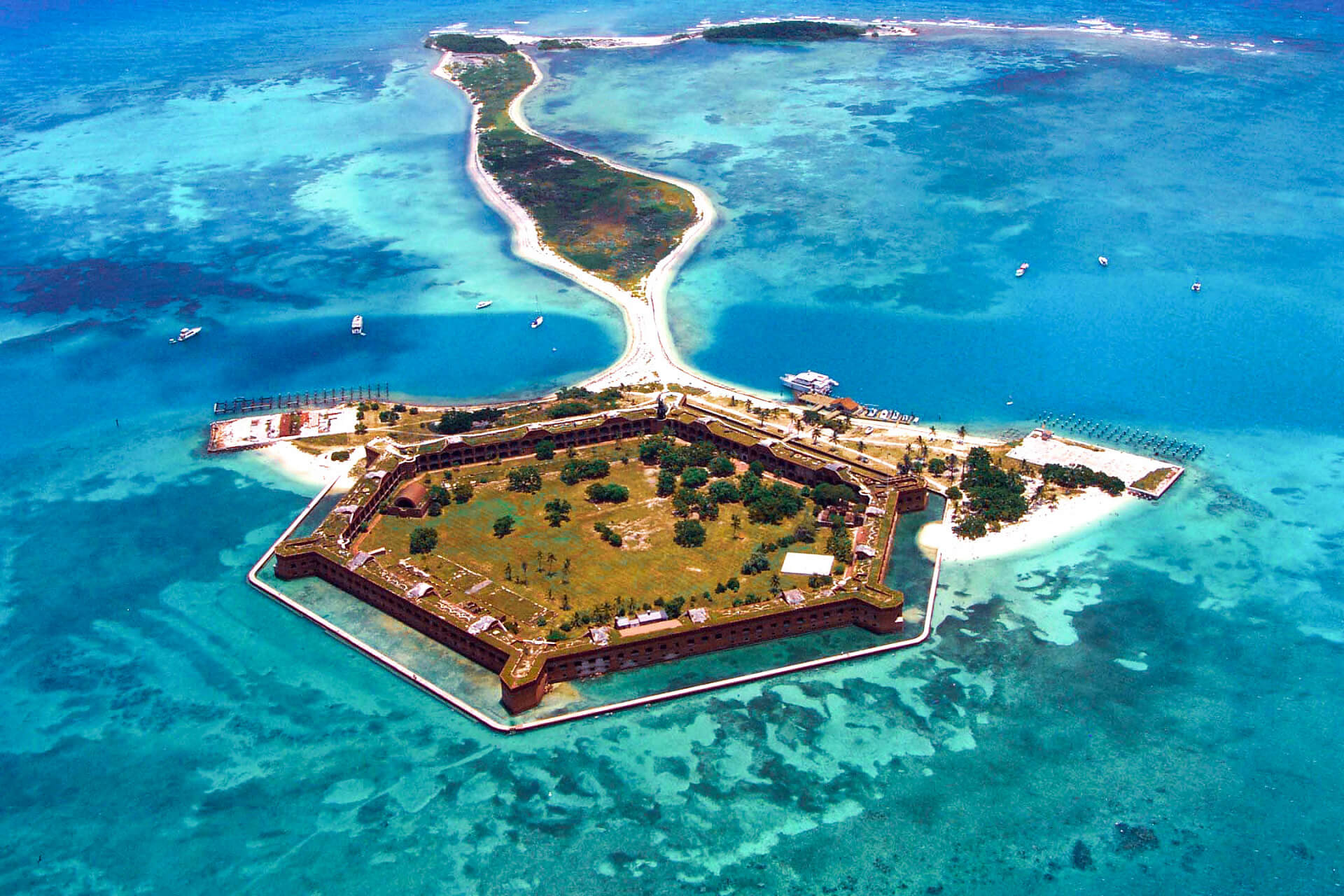The Dry Tortugas National Park, a hidden gem in the Gulf of Mexico, is a magnificent underwater national park with stunning marine life and compelling dive spots. Its distinctive characteristics as an underwater national park provide divers and snorkelers with an unforgettable experience.
The Dry Tortugas are a collection of seven small islands located about 70 miles west of Key West, Florida. It is well-known for its clean waters, diverse marine life, and historical significance. The 101-square-mile park was formed to conserve and preserve the marine and avian life within its bounds.
Unlike traditional national parks that focus on terrestrial habitats, Dry Tortugas is mostly an underwater national park, with 99% of its land area below sea level. As a result, it is a haven for marine life and an excellent location for underwater exploration.

History and Formation
The Dry Tortugas are an excellent example of a coral reef system that has changed over time. The islands were produced by the deposition of coral skeletons and silt on the remains of old coral reefs.
The indigenous Calusa people, who had lived in the area for thousands of years, were the first to discover it. Later, European explorers such as Ponce de León and Juan Ponce de León were awestruck by the beauty of these islands.
Dry Tortugas National Park was established in 1935 to safeguard the island’s distinctive marine and wildlife. The region was officially recognized for its ecological and historical value.
Biodiversity and Marine Life
Dry Tortugas has a diverse marine ecosystem, including seagrass meadows, coral reefs, and deep-water habitats. These various settings are home to a wide range of marine creatures.
The park is critical in the conservation of endangered species such as the hawksbill turtle and elkhorn coral. These endangered species might find refuge in the pure underwater habitat.
Dry Tortugas coral reefs are not only visually appealing, but also important nurseries for a variety of marine organisms.

Key Dive Sites
The Windjammer Wreck, which sits on the ocean floor as a tribute to its maritime heritage, is one of the most exciting diving sites in Dry Tortugas. This 19th-century shipwreck provides an intriguing view into history as divers swim around the ruins of a once-majestic vessel. The site is teeming with marine life, and as you explore the wreck’s nooks and crannies, you’ll come across schools of colorful fish seeking safety in the ship’s skeletal structure.
Little Africa is the excellent diving destination for people looking for spectacular marine life and coral patterns. With its enormous rocks and profusion of marine animals, this coral reef region recalls Africa’s immense savannas. Divers are treated to a spectacular show as they encounter parrotfish, butterflyfish, and angelfish darting through the beautiful coral formations. Keep a watch out for the graceful sea turtles floating through the waves, adding to the allure of this underwater wonderland.
Exploring the beautiful seagrass meadows that spread across the ocean floor when diving around East Key provides a one-of-a-kind experience. These beds provide vital habitat for juvenile marine life, acting as nurseries for a wide range of species. While diving in this location, you may see nurse sharks and stingrays delicately maneuvering the seagrass, emphasizing the necessity of maintaining these ecosystems in order to preserve marine life in the park.
Snorkeling Opportunities
The Garden Key snorkel trail is a must-see for snorkelers. This guided underwater route takes you through some of the reef’s most vivid areas, allowing you to see the kaleidoscope of hues that adorn the coral formations. Along the journey, you’ll see schools of tropical fish, curious lobsters peeking out of cracks, and maybe even a shy octopus or two. The trail is appropriate for all skill levels and provides an easy approach to see the park’s aquatic marvels.
Snorkelers at Loggerhead Key are rewarded with clean, shallow waters with exceptional visibility. This area’s wealth of marine life provides snorkelers with unique encounters. Watch for gorgeous rays gliding beneath you and playful dolphins frolicking in the distance. Snorkeling at Loggerhead Key delivers an intimate and immersive experience with the Dry Tortugas’ marine treasures.
It is critical to observe safety instructions and practice responsible snorkeling etiquette before beginning on any snorkeling trip in the Dry Tortugas. Always snorkel with a friend, use suitable equipment, and avoid touching or disturbing aquatic creatures. We can assure the preservation of these incredible vistas for future generations by being mindful of our impact on the delicate underwater habitat.

Diving Challenges and Precautions
The waters surrounding Dry Tortugas are sometimes subject to powerful currents and fluctuating tides, making diving conditions difficult. Divers must be adequately prepared and have sufficient experience to securely navigate these conditions. Before diving, it is recommended to verify the weather and tide forecasts and to seek the advice of knowledgeable dive instructors.
Although the underwater park is a mesmerizing location, it is not risk-free. Certain marine organisms, such as jellyfish and fire coral, can cause distress or even physical harm if approached carelessly. Divers must also be aware of their depth and oxygen supply to ensure a safe and enjoyable dive. In order to dive responsibly in Dry Tortugas, it is necessary to comprehend and acknowledge these potential dangers.
Before scuba diving in Dry Tortugas, visitors are typically required to submit their certifications to ensure they have the necessary skills and experience to safely explore the underwater park. Diving without the proper certification not only places you at risk, but also threatens the marine ecosystems. You contribute to the overall protection and conservation efforts by abiding by the park’s rules and demonstrating your diving proficiency.
Preservation and Conservation Efforts
Dry Tortugas, as an underwater national park, relies on stringent regulations and visitor guidelines to protect its vulnerable marine ecosystems. These regulations prohibit handling or collecting marine life, impose restrictions on anchoring, and designate specific areas for various recreational activities. By adhering to these regulations, visitors actively contribute to the preservation of this marine paradise.
In order to better understand and protect the marine life in Dry Tortugas, scientific research and monitoring are integral to the administration of the park. Numerous aspects of the ecosystem, such as coral health, fish populations, and water purity, are the subject of scientific and marine biologist research. This information not only aids in identifying potential threats, but also in devising effective conservation strategies to ensure the underwater national park’s long-term viability.
Dry Tortugas conservation efforts extend beyond park boundaries. To cultivate a sense of stewardship and responsibility for this unique marine environment, it is essential to engage the local community and visitors in educational programs. Through guided tours, seminars, and educational materials, visitors gain a deeper appreciation for the underwater marvels they observe, inspiring them to become marine conservation advocates.
Accommodations and Visiting Tips
Camping on Dry Tortugas offers those seeking an immersive experience the opportunity to connect with nature. On Garden Key, the park offers camping facilities, enabling campers to witness breathtaking sunrises and sunsets over the turquoise waters. Permits for camping must be secured in advance, as the number of available places is limited to protect the fragile ecosystem of the island.
Although day trips to Dry Tortugas are conceivable, visitors can truly appreciate the park’s beauty by staying overnight. Day trips provide limited time for investigation, whereas overnight stays allow visitors to experience the park’s tranquil and secluded atmosphere, both during the day and after the day-trippers have departed.
Due to its remote location, Dry Tortugas requires careful planning for a successful visit. Ensure you have all necessary camping and transportation permits and reservations. It is recommended to prepare responsibly, bringing only what is necessary and adhering to the leave-no-trace principles of the park. By preparing in advance, you can maximize your time in this underwater sanctuary.
Captivating Underwater Photography
Capturing the underwater beauty of Dry Tortugas requires a special set of photography talents. Photographing underwater requires perseverance, buoyancy control, and an eye for composition. Photographers who master these techniques can create visually arresting depictions of the park’s splendor.
Underwater photography is a potent instrument for increasing public awareness of the significance of marine conservation. Photographers can motivate others to protect these fragile ecosystems and support ongoing conservation efforts by showcasing the astounding marine biodiversity and captivating landscapes.
By sharing their photographs with scientists and park officials, photographers who visit Dry Tortugas can contribute to conservation efforts. These photographs aid in the preservation of this unique underwater national park by documenting the presence of rare or endangered species and aiding in the monitoring of changes to the ecosystem.

